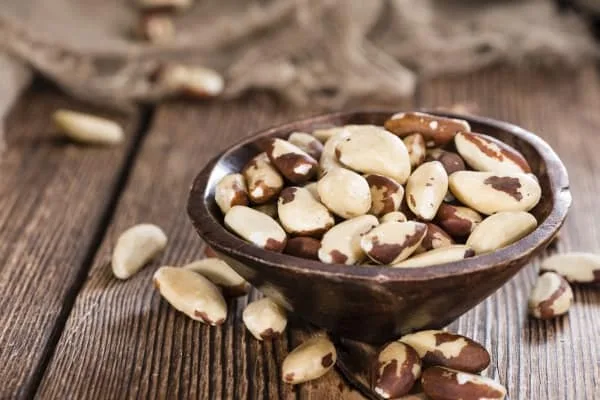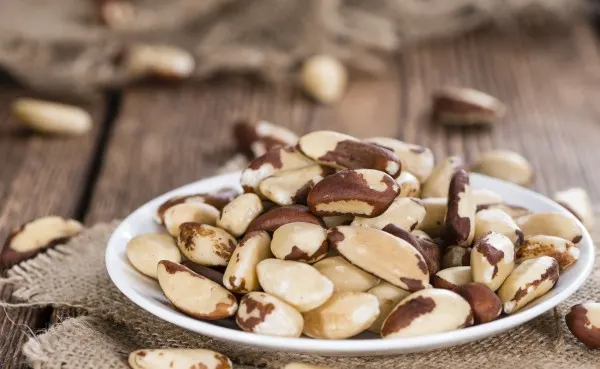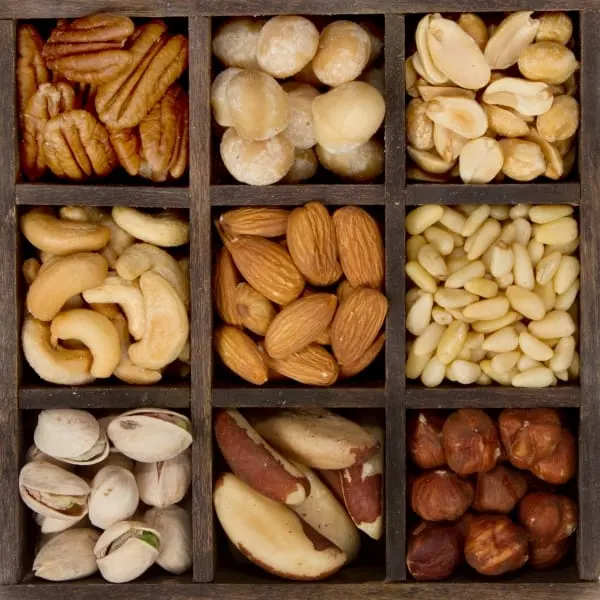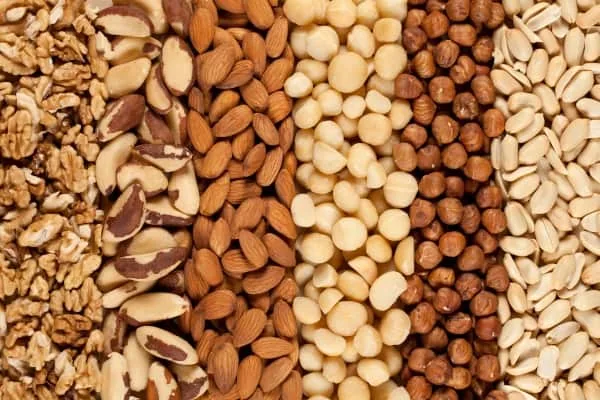In this article, we’re going to talk about the shelf life, storage, and spoilage of Brazil nuts.
Have you bought Brazil nuts and forgot about the package right after putting it in storage? These nuts are now “expired” for a few months, and you wonder: do Brazil nuts go bad?
If that sounds familiar, you need to learn how long Brazil nuts last, the best way to store them, and how to tell that a Brazil nut is bad. And that’s what we cover below.
Let’s dive in.
Table of Contents
- Do Brazil Nuts Go Bad?
- How to Tell if Brazil Nuts Are Bad?
- How Long Do Brazil Nuts Last?
- How to Store Brazil Nuts?
- Can You Freeze Brazil Nuts?
- Brazil Nuts Shelf Life and Spoilage Summary

Do Brazil Nuts Go Bad?
Brazil nuts go rancid if you store them for too long or in bad conditions. That’s the most common way Brazil nuts go bad.
Like other nuts, Brazil nuts go rancid at some point. So, how do you know that your Brazil nuts are rancid?
Typical signs of rancidity include:
- Altered flavor. If your Brazil nuts taste harsh and bitter, they’re rancid.
- Smell change. If the smell reminds you of old paint, putty, or maybe nail polish remover, that’s a sure sign.
Of the two, flavor change is much more common. That means you need to eat a nut or two to make sure yours are rancid (or not).
That said, rancid nuts aren’t necessarily unsafe to eat, but they taste quite bad. Therefore, I suggest you discard them without giving it a second thought.
Besides rancidity, there are a couple of other possible spoilage signs. Let’s talk about those.

How to Tell if Brazil Nuts Are Bad?
Signs of spoiled Brazil nuts include:
- Rancidity. If your Brazil nuts are rancid, get rid of them. Check the previous section to learn more about the telltale signs of rancidity.
- Pantry bugs in the bag. If you leave Brazil nuts at room temperature and have insect issues, they might infest the nuts too. Toss the nuts if you notice any eggs, larvae, or alive insects.
- Mold. Nuts aren’t prone to mold growth, but everything is possible with the right conditions (humidity and warm temperature). If there’s any mold, discard the nuts.
The amount of polyunsaturated fatty acids in Brazil nuts isn’t particularly high (a bit over 30 percent of the overall fat). Because of that, these nuts don’t go rancid fast but aren’t super resistant to the process either.
That means if you follow good storage practices (more on that later), yours should last quite some time.
Brazil nuts come with their skins partially still on, and that’s okay. No need to remove them before eating. You don’t need to remove the skins from hazelnuts either.
Now, what if your Brazil nuts aren’t rancid, but the skins are wrinkled, the nutmeat dried, and they taste stale?
Using Stale Brazil Nuts
You can try a couple of things to get the most out of your old and stale Brazil nuts. Those are:
- Roasting. There are a few ways of roasting Brazil nuts, and with the help of some extra ingredients, you can make them taste great again.
- Add to ice cream or top desserts. Adding some chopped Brazil nuts can add that extra bit of crunch that will make a good dessert great. Start with small quantities, though.
- Fold into baked goods like muffins, cupcakes, and various other cakes. Grab a trusted recipe and experiment with adding some Brazil nuts to it. Again, add only a bit so that you don’t overdo it.
Those options work well for using other stale nuts too. Some examples include macadamia nuts (Can macadamia nuts go bad?) and cashews (Do cashews go bad?).

How Long Do Brazil Nuts Last?
Brazil nuts last about six months in a sealed bag at room temperature and more than a year if refrigerated. If you need them to last even longer, freeze them.
If you checked a bunch of packages of Brazil nuts, you would find that their best-by dates usually range from 6 months to a year. And that’s about how long you can store those nuts at ambient temperature.
If you need to store Brazil nuts for longer than 6 to 9 months, choose the fridge instead. The cold temperature will slow down rancidification and give you more time to enjoy the nuts.
Like other nuts, freezing is the ultimate option if you need to prolong the shelf life of Brazil nuts for months, if not years.
Last, remember that eating a whole bunch of Brazil nuts at once is a bad idea.
These nuts are very high in selenium (they are actually recommended in treating selenium deficit), and eating too many might lead to selenium toxicity. Stick to one to three Brazil nuts a day, and you’ll be fine.
“Expired” Brazil Nuts
If you’re buying Brazil nuts bagged, there’s a best-by date on the label. That date is only a rough estimate of how long those nuts should last, and it definitely isn’t an “expiration” date.
What’s more, Brazil nuts typically keep way past the printed date.
Long story short, instead of paying attention to that date, it’s better to check the nuts’ overall quality and look for signs of spoilage. And if everything seems to be fine, feel free to dig in.
(Obviously, if your Brazil nuts are months past their date, and that makes you uncomfortable eating them, discard them. Better safe than sorry.)
Now, having the shelf life out of the way, it’s time to talk about storage practices.

How to Store Brazil Nuts?
Store brazil nuts in a dark place away from heat sources, and seal them tight in a freezer bag or airtight container.
You can leave them at room temperature if a couple of months of storage time is enough. For a more prolonged shelf life of a year or more, you need to refrigerate them instead.
Of course, not much will happen if you leave the nuts on the counter in an open bag for a couple of days or a week or two.
Unless they sit next to the stove, they won’t go rancid or anything. But keeping them there for a prolonged period will drastically shorten their shelf life.
Because of that, if you buy Brazil nuts from the bulk containers in a supermarket, choose a place with a high turnover. Unfortunately, the storage conditions in most supermarkets usually aren’t that good (transparent containers that are always open), so they might not last as long as you’d like.
(Or buy them pre-bagged to ensure they’ll last a long time.)
If you refrigerate Brazil nuts, don’t leave them half-open. Shelled nuts absorb external moisture and odors, so that’s an easy way to shorten their shelf life or make them smell weird.
Last, let’s cover freezing Brazil nuts.
Can You Freeze Brazil Nuts?
Brazil nuts freeze fine, and the procedure is as simple as it gets.
Here’s how you freeze Brazil nuts:
- Place the Brazil nuts in a freezer bag.
- Squeeze out any extra air.
- Label the bag with the name and date if you like.
- Seal the bag.
- Freeze it.
That’s it: no pre-freezing, blanching, or any of that. You just package them and throw them in the freezer.
To use frozen Brazil nuts, scoop a bunch and let them defrost on the counter. Half an hour or so should be enough for snacking. If you need them for baking, you can probably skip that part.
Brazil Nuts Shelf Life and Spoilage Summary
Thanks for reading this guide on Brazil nuts. Here are the main points we covered:
- Brazil nuts go rancid if they sit too long in storage. Pantry bugs could also infest the pack, or the nuts could grow mold, but rancidity is the most common issue.
- Rancid Brazil nuts taste sharp and bitter. They might also smell like old paint or nail polish remover, but flavor alteration is much more common than odor change.
- The date on a bag of Brazil nuts is usually between 6 months to a year of packaging. But if you keep the nuts sealed and away from heat sources, they should retain decent quality way past that period.
- You can store Brazil nuts in a sealed bag or airtight container. Stored this way, they’ll last 6 months or so at room temperature and more than a year in the fridge.